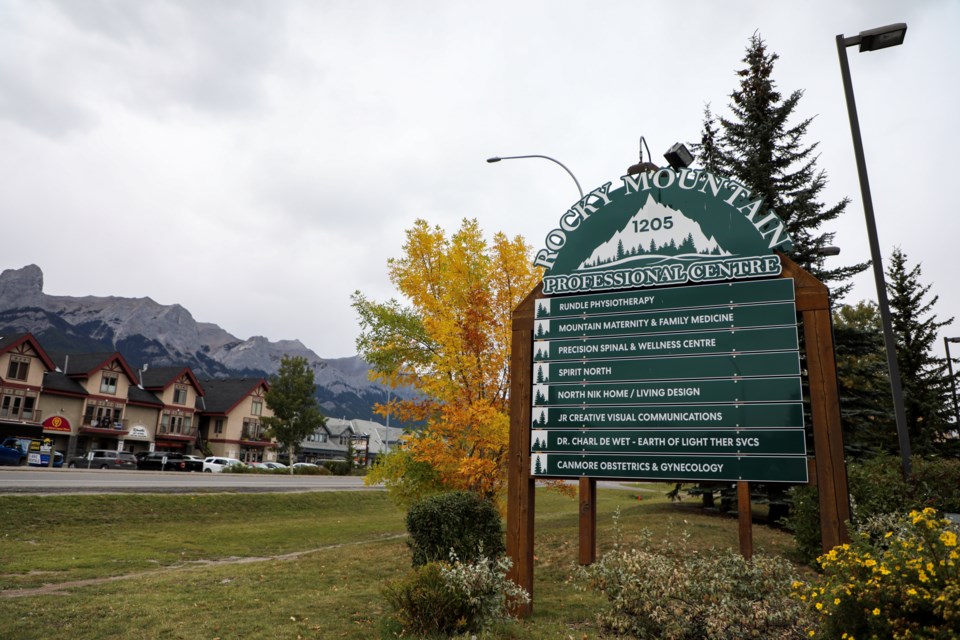BOW VALLEY – The list of people in search of a family doctor in the Bow Valley will get a little shorter with the addition of a much-needed physician at a Canmore clinic last week, but the area is “definitely still in a deficit” when it comes to primary health care provision, say local experts.
Dr. Lianne Reelie’s first day at Mountain Maternity and Family Medicine was Wednesday (Oct. 25) and the new Canmore resident said she’s already booked up to the end of December with patient meet-and-greets.
“I’m still accepting. I’m getting pretty full,” she said. “I actually have a limited number of hours that I’m going to be opening up to accommodate because there’s been so much uptake with the meet-and-greets.”
According to Alberta’s Primary Care Networks Find a Doctor website, there is only one other doctor in the area accepting new patients. In Banff, Bear Street Family Physicians is also noted as accepting new patients under a team-based care model.
The number of family physicians accepting patients via the site, according to the website, decreased 79 per cent from 2020-23. In 2020, there were 887 family doctors on the website accepting new patients, but by the end of September 2023, there were 190.
Bow Valley Primary Care Network president and physician at Ridgeview Medical Clinic in Canmore, Dr. Kendra Barrick, said about 14 doctors have moved away, closed a practice, or retired from the Bow Valley in recent years.
Barrick said it’s difficult to measure how many physicians the area would need to fill the resulting gap in patient care, but that there are thousands of people in the Bow Valley without a family doctor.
“It’s kind of a dynamic thing with different panel sizes and the dynamic nature of our population,” she said. “But definitely, we have had a large number of physicians who have left the Bow Valley over the past two to three years. So, we definitely are still in a deficit.”
The province released final reports and recommendations last week made by two advisory panels struck in 2022 to inform the Modernizing Alberta’s Primary Health Care System (MAPS) in first steps to improving access to family doctors and health professionals, including separating primary and Indigenous healthcare divisions.
Both the primary and Indigenous care divisions will have their own deputy minister and staff to focus on ensuring the development of policy and implementation of other commitments brought forward.
“Right now, we don't have that,” said Health Minister Adriana LaGrange at an Oct. 18 press conference. “That doesn't exist within the department, and it needs to exist, given the prominence that we are making on these very important processes of MAPS and the Indigenous MAPS. It doesn't exist now, but it's going to, and it's going to make a positive difference.
The measures introduced by LaGrange also put in place a move toward fully integrating nurse practitioners into the healthcare system, allowing nurse practitioners to open their own clinics.
Collaborative efforts with the Alberta Medical Association (AMA) aim to modernize physician compensation, enhance primary care governance, and reduce administrative burdens for a more stable healthcare system.
A preliminary report is expected in January 2024 with a final report two months later, in time to inform the province’s 2024 budget.
“That’s why I'll be working very closely with the Alberta Medical Association looking at a compensation model that we can move forward on,” LaGrange said. “We know that more is required, but what that number is, we don't know just yet.”
What is known is $57 million has been allocated over three years to provide family doctors and nurse practitioners with initial administrative support. Annually, each provider could receive up to $10,000.
While the plan aims to help address healthcare deficits within the province, Barrick said the five- to 10-year timeline the province has allotted for it makes planning for the Bow Valley's needs, and other regions, challenging.
“There’s still a lot in the next five to 10 years which is going to change so there’s no concrete plans yet with the timeline,” she said.
“What are our needs? Well, that’s going to change a lot based on what the government allows us to do in a lot of ways and what their mandates are for physicians versus nurse practitioners, funding models. There’s a lot of dynamic pieces right now.”
Dr. Brendan Flowers, owner of Mountain Maternity and Family Medicine, said the clinic’s recent implementation of a locum-run episodic care model in September is one way it’s successfully attaching more patients to doctors while the province works out its plan to repair the primary care system.
“This idea came out of the reality of other clinics running this model successfully and the fortunate situation where locums are looking to work here and patients are needing and wanting to be seen,” said Flowers, adding the clinic currently has one locum physician at the clinic four to five days a week for the next three months. Following that, another physician will join the clinic for three months, from January to February.
Flowers said the model is working and providing a unique opportunity to blend continuity of care and increased access to care. While the Canmore doctor said he believes the concept of MAPS is wonderful, the topics of concern raised have "existed for years."
“I think it was Rachel Notley (NDP Opposition Leader) who said 'this is a plan to make a plan,’” he said. “I’m unaware of any tangible change or steps that will be taken to actually implement positive impact on this healthcare system at this point. To have an additional consultation process, it’s wonderful to include the AMA and that’s an important component, but I think there’s just too few details to really know what that looks like, let alone what the positive or negative impacts are downstream from that.”
The Local Journalism Initiative is funded by the Government of Canada. The position covers Îyârhe (Stoney) Nakoda First Nation and Kananaskis Country.




